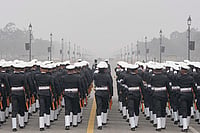
The Tejas Mk1A successfully completed its first flight from HAL’s Nashik facility
The Mk1A is a 4.5-generation multirole fighter featuring AESA radar, advanced electronic warfare systems, BVR missile capability and digital fly-by-wire controls
The Tejas Mk1A is being developed to replace the recently retired MiG-21 fighter jets of the Indian Air Force (IAF).
The Light Combat Aircraft (LCA) Tejas Mk1A successfully completed its first flight from Hindustan Aeronautics Limited’s (HAL) Nashik plant on Friday, October 17, in the presence of Defence Minister Rajnath Singh. The event also marked the inauguration of HAL’s third Tejas production line, boosting India’s indigenous fighter aircraft programme.
Alongside the Tejas Mk1A flight, Defence Minister Singh inaugurated HAL’s third production line for the aircraft at Nashik, which can produce up to eight jets annually. Combined with the two existing Bengaluru lines that manufacture 16 aircraft per year, HAL’s total annual capacity will now reach 24 Tejas jets. The Nashik facility, initiated in 2023, was established to accelerate deliveries to the IAF.
The Minister also unveiled the second production line for the Hindustan Turbo Trainer (HTT)-40 basic trainer aircraft. These additions represent a significant expansion of HAL’s manufacturing infrastructure.
The Tejas Mk1A is being developed to replace the recently retired MiG-21 fighter jets of the Indian Air Force (IAF). The first aircraft is expected to be delivered to the IAF by the end of October, marking a major milestone in India’s efforts towards self-reliance.
Advancements in the Tejas Mk1A
The Tejas Mk1A is an upgraded version of the earlier Mk1 variant. It incorporates advanced systems such as the Israel EL/M-2052 AESA radar, an enhanced electronic warfare suite with a self-protection jammer, and Beyond Visual Range (BVR) missile capability. The aircraft features a fully digital fly-by-wire control system, replacing traditional mechanical controls, and has nine hardpoints for carrying various weapons, including the indigenous ASTRA missile and Israel’s Derby missile.
Designed for air defense, ground attack, and maritime missions, the 4.5-generation multirole fighter has over 50 percent indigenous components. It also supports mid-air refueling, enhancing operational range and endurance.
Contracts and Delivery Plans
HAL has secured two major contracts for Tejas production:
A Rs 48,000 crore deal signed in February 2021 for 83 Mk1A jets.
A Rs 62,370 crore agreement finalised in September 2025 for 97 additional aircraft.
The company aims to deliver the 83 aircraft ordered in 2021 over the next four years. However, delays in engine supplies from GE Aerospace in the United States have pushed initial deliveries beyond the original February 2024 target.
The IAF currently operates 29 fighter squadrons, well below the sanctioned strength of 42. The induction of Tejas Mk1A jets will help close this gap and enhance India’s combat readiness. The modernised fleet will provide the IAF with improved operational flexibility and reduced reliance on aging foreign aircraft.






















